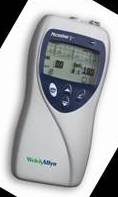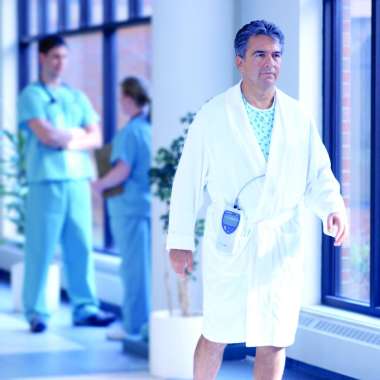Handheld cardiac monitors reduce cardiac risk at Royal Infirmary of Edinburgh
2 October 2009
NHS Lothian has rolled out a state-of-the-art patient monitoring system to improve care for cardiac surgery patients. Handheld devices that monitor blood pressure, heart rate and oxygen levels, have been put in place in the Royal Infirmary of Edinburgh (RIE) to prevent complications, such as cardiac arrest and deep vein thrombosis.
NHS Lothian is one of the first in the UK to introduce the small wireless Micropaq devices which have helped transform patient care and save lives. The portable machines help to warn medics of any complications before they arise by recording and analysing the crucial data from individual patients.
 It means that staff can monitor patients at the bedside and
throughout the ward, rather than moving each person to a wall-mounted
monitoring station.
It means that staff can monitor patients at the bedside and
throughout the ward, rather than moving each person to a wall-mounted
monitoring station.
Patients can also begin their recovery much faster as the machines help physiotherapists to monitor exactly how much exercise is required. Experts can even predict the length of a stay removing the risk of patients being sent home too soon.
Dr David Scott, Consultant Cardiothoracic Anaesthetist, NHS Lothian said: “We have seen a significant reduction in patients suffering a cardiac arrest on the ward or being discharged with potentially life-threatening cardiac arrhythmias following cardiac surgery. Cardiac thresholds can now not only be monitored at the bedside, but remotely throughout the ward. The quality of the monitor screens is exceptional and clearly shows irregularities in cardiac electrophysiology.”

A total of six devices were drafted in to ward 102 as a pilot project in 2007. However they have been so successful that NHS Lothian increased the number to 20 earlier this year.
The machines, manufactured by Welch Allyn, are connected remotely to a central hub, called the Acuity Central Station. They are about the size of a cordless phone and are carried in a small pouch.
The monitors provide remote data on ECG waveforms, oxygen saturation, heart rate and rhythm and are especially useful when patients are transferred from high-dependency or critical care units.
Lynn Stewart, Ward Manager, said: “Monitoring at this level allows us to identify dipping potassium levels following cardiac surgery, minimising the risk of a ventricular arrhythmia. It also provides an early indication that intervention is required and should a patient emergency occur, the nurse in charge will be alerted to vital signs alarms without what might otherwise be a life-threatening delay. We have also found it helps physiotherapists to initiate exercise programmes designed to help patients post-operatively at the earliest opportunity.”
Bookmark this page